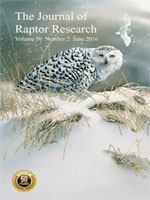The Chinese Sparrowhawk (Accipiter soloensis) is a little-known raptor distributed in southeast Asia. We here report a 5 yr study on its breeding biology at Dongzhai National Nature Reserve in Henan Province, central China. We banded 270 individuals (84 adults, 186 fledglings), recorded nest tree characteristics, and monitored nests with 24-hr digital cameras, video cameras, and ground observations from blinds. Among the 133 nests found, 91.7% were built on broad-leaved trees. Among 47 nests with known nest initiation dates, 57.4% were in mid-May. The most commonly used trees for nesting were chestnut (Castanea mollissima; 59.4%) and Chinese wingnut (Pterocarya stenoptera; 19.5%). Egg-laying occurred from 17 May to 17 June, with the largest number between 31 May and 4 June (n = 45, 28.9%). Eggs were laid throughout the day and also at night. Mean clutch size was 3.16 ± 0.75 eggs, with no significant interannual variation. Females contributed 87.4% of the total incubation effort. The incubation period was 28 ± 2 d (range 24–31 d, n = 46), and the nestlings fledged in 20.4 ± 1.6 d (range 18–25, n = 27). Overall breeding success was 58.7%, with no significant interannual variation. The daily nest survival rate was 0.993 ± 0.002 during incubation period, and 0.981 ± 0.003 during nestling period. Predation of eggs and nestlings by snakes and Eurasian Jays (Garrulus glandarius) was the main cause of nest failure.
How to translate text using browser tools
1 June 2016
Breeding Biology of a Little-Known Raptor in Central China: The Chinese Sparrowhawk (Accipiter soloensis)
Qiang Ma

Journal of Raptor Research
Vol. 50 • No. 2
June 2016
Vol. 50 • No. 2
June 2016
Accipiter soloensis
breeding biology
China
Chinese Sparrowhawk
clutch size
nesting success




